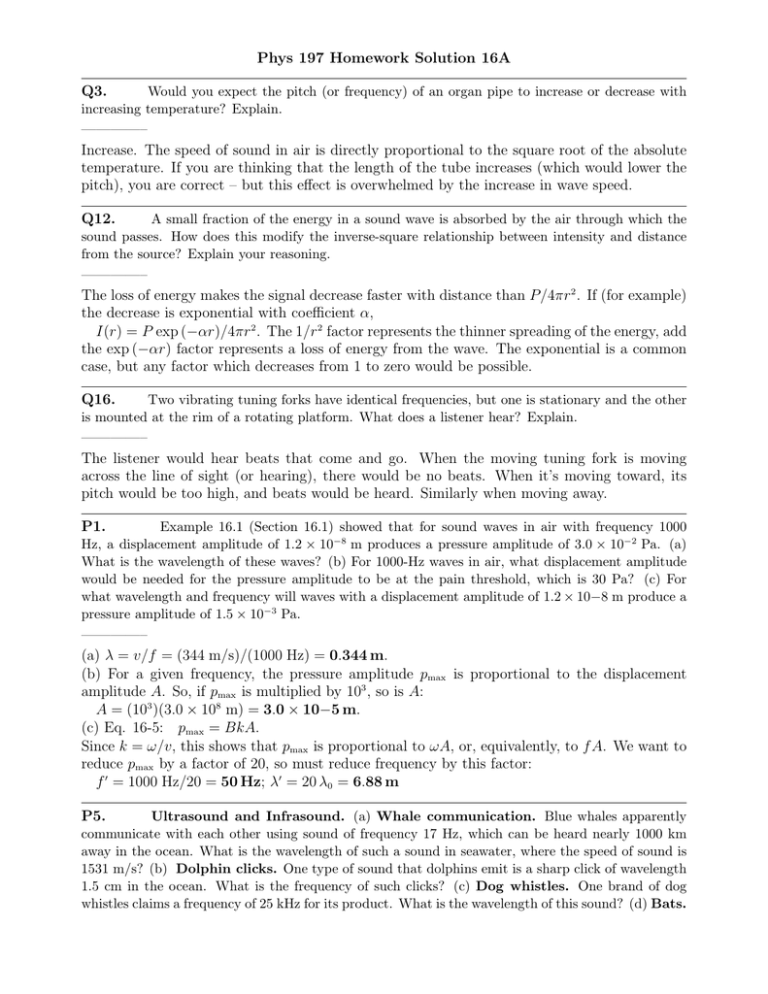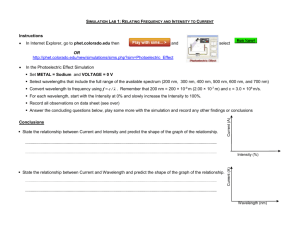Phys 197 Homework Solution 16A Q3.
advertisement

Phys 197 Homework Solution 16A Q3. Would you expect the pitch (or frequency) of an organ pipe to increase or decrease with increasing temperature? Explain. ————– Increase. The speed of sound in air is directly proportional to the square root of the absolute temperature. If you are thinking that the length of the tube increases (which would lower the pitch), you are correct – but this effect is overwhelmed by the increase in wave speed. Q12. A small fraction of the energy in a sound wave is absorbed by the air through which the sound passes. How does this modify the inverse-square relationship between intensity and distance from the source? Explain your reasoning. ————– The loss of energy makes the signal decrease faster with distance than P/4πr2 . If (for example) the decrease is exponential with coefficient α, I(r) = P exp (−αr)/4πr2 . The 1/r2 factor represents the thinner spreading of the energy, add the exp (−αr) factor represents a loss of energy from the wave. The exponential is a common case, but any factor which decreases from 1 to zero would be possible. Q16. Two vibrating tuning forks have identical frequencies, but one is stationary and the other is mounted at the rim of a rotating platform. What does a listener hear? Explain. ————– The listener would hear beats that come and go. When the moving tuning fork is moving across the line of sight (or hearing), there would be no beats. When it’s moving toward, its pitch would be too high, and beats would be heard. Similarly when moving away. P1. Example 16.1 (Section 16.1) showed that for sound waves in air with frequency 1000 Hz, a displacement amplitude of 1.2 × 10−8 m produces a pressure amplitude of 3.0 × 10−2 Pa. (a) What is the wavelength of these waves? (b) For 1000-Hz waves in air, what displacement amplitude would be needed for the pressure amplitude to be at the pain threshold, which is 30 Pa? (c) For what wavelength and frequency will waves with a displacement amplitude of 1.2 × 10−8 m produce a pressure amplitude of 1.5 × 10−3 Pa. ————– (a) λ = v/f = (344 m/s)/(1000 Hz) = 0.344 m. (b) For a given frequency, the pressure amplitude pmax is proportional to the displacement amplitude A. So, if pmax is multiplied by 103 , so is A: A = (103 )(3.0 × 108 m) = 3.0 × 10−5 m. (c) Eq. 16-5: pmax = BkA. Since k = ω/v, this shows that pmax is proportional to ωA, or, equivalently, to f A. We want to reduce pmax by a factor of 20, so must reduce frequency by this factor: f ′ = 1000 Hz/20 = 50 Hz; λ′ = 20 λ0 = 6.88 m P5. Ultrasound and Infrasound. (a) Whale communication. Blue whales apparently communicate with each other using sound of frequency 17 Hz, which can be heard nearly 1000 km away in the ocean. What is the wavelength of such a sound in seawater, where the speed of sound is 1531 m/s? (b) Dolphin clicks. One type of sound that dolphins emit is a sharp click of wavelength 1.5 cm in the ocean. What is the frequency of such clicks? (c) Dog whistles. One brand of dog whistles claims a frequency of 25 kHz for its product. What is the wavelength of this sound? (d) Bats. While bats emit a wide variety of sounds, one type emits pulses of sound having a frequency between 39 kHz and 78 kHz. What is the range of wavelengths of this sound? (e) Sonograms. Ultrasound is used to view the interior of the body, much as x-rays are utilized. For sharp imagery, the wavelength of the sound should be around one-fourth (or less) the size of the objects to be viewed. Approximately what frequency of sound is needed to produce a clear image of a tumor that is 1.0 mm across if the speed of sound in the tissue is 1550 m/s? ————– (a) v = λf ⇒ λ = v/f = (1531 m/s)/(17 Hz) = 90 m (b) f = v/λ = (1531 m/s)/(0.015 m) = 102 kHz. (c) In air, v = 344 m/s. λ = v/f = (344 m/s)/(25 000 Hz) = 0.014 m. (d) λ1 = (344 m/s)/(39 000 Hz) = 8.8 mm; λ2 = 4.4 mm; (e) λ = (0.001 m)/4 = 0.25 mm. f = v/λ = (1550 m/s)/(2.5 × 10−4 m) = 6.2 Hz. P18. You live on a busy street, but as a music lover, you want to reduce the traffic noise. (a) If you install special sound-reflecting windows that reduce the sound intensity level (in dB) by 30 dB, by what fraction have you lowered the sound intensity (in W/m2 )? (b) If, instead, you reduce the intensity by half, what change (in dB) do you make in the sound intensity level? ————– (a) Using β as the symbol for the intensity level in dB, the basic equation is β = 10 log I/I0 , where log is base-10. −30 = 10 log I/I0 ⇒ I/I0 = 10−3 . Sound intensity has been reduced by a factor of 1000 for 30 dB. Here, I took I0 as the original intensity level on the street, and took β as −30 because it is a reduction. (b) β = 10 log(0.5) = −3.01 dB = −3 dB. Reduced by a mere 3 dB. P24. (a) If two sounds differ by 5.00 dB, find the ratio of the intensity of the louder sound to that of the softer one. (b) If one sound is 100 times as intense as another, by how much do they differ in sound intensity level (in decibels)? (c) If you increase the volume of your stereo so that the intensity doubles, by how much does the sound intensity level increase? ————– (a) β = 10 log I/I0 ⇒ I/I0 = 10β/10 = 100.5 = 3.16. (b) β = 10 log(100) = 20 dB. (c) Same as P18(b): 3 dB. P26. The fundamental frequency of a pipe that is open at both ends is 594 Hz. (a) How long is this pipe? If one end is now closed, find (b) the wavelength and (c) the frequency of the new fundamental. ————– (a) For an open-open pipe, f1 = v/2L ⇒ . L = v/2f1 = (344 m/s)/(2 · 594 Hz) = 0.290 m. (b) For open-closed, f1 = v/4L, so half the frequency: 297 Hz. (c) λ = v/f = (344 m/s)/(297 Hz) = 1.16 m. We could also have used λ = 4L for the open-closed tube. P29. A certain pipe produces a fundamental frequency of 262 Hz in air. (a) If the pipe is filled with helium at the same temperature, what fundamental frequency does it produce? (The molar mass of air is 28.8 g/mol and the molar mass of helium is 4.00 g/mol) (b) Does your answer to part (a) depend on whether the pipe is open or stopped? Why or why not? ————– Since f1 = v/2L p or v/4L, we see that f1 is proportional to v. We have v =p γRT /M , so the ratio p vHe /vair = γHe Mair /γair MHe = 1.67 · 28.8/1.4 · 4 = 2.93. fHe = 2.93 · 262 Hz = 768 Hz. Don’t sweat it if you didn’t know that γHe = 1.67 and you used the same gamma and got 702 Hz.




